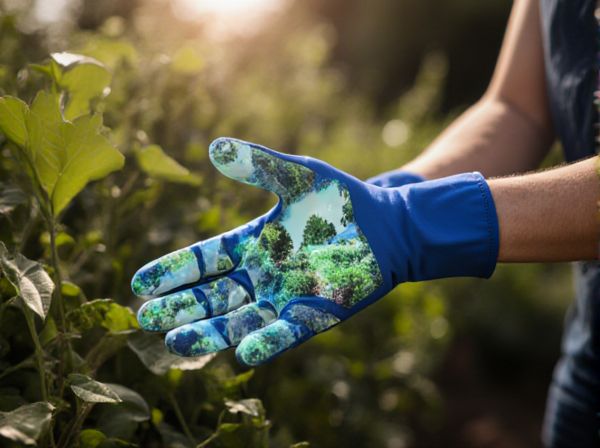
Solarization vs flame weeding Illustration
Solarization uses clear plastic to trap solar radiation, raising soil temperature to eliminate weed seeds and pathogens effectively. Flame weeding applies intense heat directly to weed foliage, causing cell rupture and plant death without soil disturbance. Solarization offers long-term soil sterilization, while flame weeding provides immediate weed control but requires repeated applications.
Table of Comparison
| Aspect | Solarization | Flame Weeding |
|---|---|---|
| Method | Using clear plastic to trap solar heat and kill weed seeds | Using propane-fueled flame to directly burn weeds |
| Effectiveness | Kills weed seeds and soil pathogens over 4-6 weeks | Kills above-ground weeds immediately but not roots or seeds |
| Time Frame | 4 to 6 weeks for soil treatment | Immediate weedburn with repeated applications |
| Environmental Impact | Eco-friendly, no chemicals or fuel consumption | Emits CO2, risk of fire hazards |
| Cost | Low cost - plastic sheets required | Higher cost - fuel and equipment needed |
| Best Use | Pre-plant soil sanitation in gardens and fields | Quick weed control in established crops and pathways |
| Limitations | Requires sunny, warm conditions and time | Not effective on deep-rooted perennials; risk to crops |
Introduction to Weed Management Techniques
Solarization uses clear plastic to trap solar energy, raising soil temperature to eliminate weed seeds and soil pathogens effectively. Flame weeding applies direct heat through propane torches to damage above-ground weed tissues, offering rapid and selective weed control without chemicals. Both techniques provide eco-friendly alternatives in integrated weed management, with solarization targeting soil-borne issues and flame weeding focusing on emerging weed growth.
What is Solarization?
Solarization is an eco-friendly weed control method that uses clear plastic sheets to trap solar energy, heating the soil to temperatures between 110degF and 125degF (43degC to 52degC). This process effectively kills weed seeds, pathogens, and pests by disrupting their cellular structure, promoting healthier soil for crop growth. Solarization is a sustainable alternative to chemical herbicides, enhancing soil fertility while reducing weed pressure in agricultural and gardening settings.
What is Flame Weeding?
Flame weeding is a non-chemical weed control method that uses intense heat from a propane torch to damage or kill unwanted plants by rupturing their cell membranes. This technique targets seedlings and shallow-rooted weeds without disturbing the soil structure, making it suitable for organic farming and garden maintenance. Compared to solarization, which relies on prolonged heat exposure under plastic covers, flame weeding provides immediate weed suppression but requires careful application to avoid crop damage or fire hazards.
How Solarization Works to Control Weeds
Solarization controls weeds by trapping solar energy under a transparent plastic cover, raising soil temperatures to levels lethal for weed seeds and pathogens. This process typically requires 4 to 6 weeks of intense sunlight exposure, effectively sterilizing the soil and preventing weed germination. The high soil temperatures disrupt seed viability and reduce weed populations without the use of chemicals.
How Flame Weeding Targets Unwanted Plants
Flame weeding targets unwanted plants by exposing them to intense, direct heat that causes rapid cell rupture and protein coagulation, effectively killing seedlings and small weeds without affecting soil structure. Unlike solarization, which relies on prolonged soil heating under plastic to eliminate weed seeds and pathogens, flame weeding offers immediate control by destroying above-ground plant tissues. This method is especially effective for organic farming systems seeking chemical-free weed management solutions.
Pros and Cons of Solarization
Solarization uses solar energy to heat the soil, effectively killing weed seeds and soil pathogens without harmful chemicals, making it an eco-friendly weed control method. It improves soil health by enhancing microbial activity but requires several weeks of sunny weather to be effective, limiting its use in cooler or cloudy climates. While flame weeding provides immediate results, solarization's long-term soil benefits and weed seed eradication offer a sustainable alternative despite its slower process.
Pros and Cons of Flame Weeding
Flame weeding offers the advantage of rapid weed destruction without soil disturbance, reducing erosion risk and preserving soil structure. It can effectively target young, small weeds but may require multiple applications for mature plants and carries a fire hazard in dry conditions. This method avoids chemical residues, making it environmentally friendly but demands careful operator skill to prevent crop damage.
Environmental Impact: Solarization vs. Flame Weeding
Solarization involves covering soil with clear plastic to trap solar energy, effectively killing weeds and soil pathogens through high temperatures without emissions, making it an environmentally friendly alternative to chemical herbicides. Flame weeding uses propane-fueled torches to burn weed foliage, releasing greenhouse gases and producing carbon emissions that contribute to air pollution. Solarization also improves soil health by increasing microbial activity, while flame weeding may negatively affect soil microorganisms due to intense heat exposure.
Best Use Cases for Each Method
Solarization excels in controlling soil-borne weed seeds and pathogens by using clear plastic to trap solar energy, making it ideal for pre-planting soil sterilization during hot, sunny periods. Flame weeding is best suited for quick elimination of young, actively growing weeds on open ground or between crop rows, providing immediate results without soil disturbance. Each method serves distinct agricultural needs: solarization for long-term soil health and pathogen reduction, flame weeding for rapid, targeted weed control.
Choosing the Right Weed Control: Key Considerations
Solarization effectively targets weed seeds by using solar heat to sterilize soil, making it ideal for long-term weed control in warm climates. Flame weeding quickly destroys above-ground weed tissue, offering immediate results but requiring repeated applications for persistent weed problems. Selecting between these methods depends on factors like climate, weed types, soil health, and environmental impact priorities.
Solarization vs flame weeding Infographic

 gardendif.com
gardendif.com